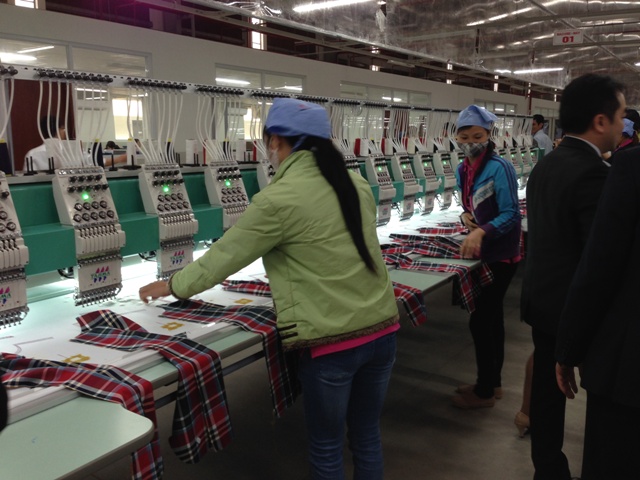Vinatex looking for heavyweight investors
| RELATED CONTENTS: | |
| PM urges Vinatex reform | |
| Textile sector growth surges | |
| Vietnam Airlines, Vinatex to go public in January | |
| Minister urges Vinatex towards better efficiency in 2017 | |
Proposed to divest near VND2.7 trillion of state capital
Six central ministries and departments have just received dispatches from the Government Office for their opinion on Vinatex’s proposal to divest all, nearly VND2.7 trillion ($119 million) state capital. The proposal was included in Vinatex’s document on resolving difficulties for its business addressed to the PM.
Le Tien Truong, general director of Vinatex, shared that the company has officially completed its equitisation in January 2015, with the chartered capital of VND5 trillion ($220 million) and state capital ownership ratio of 53.49 per cent, an equivalent of VND2.67 trillion ($117.5 million).
However, according to the PM’s Decision No.58/2016/QD-TTg, Vinatex is not on the list of companies where the government plans to retain a controlling shareholding.
“To meet the development requirements of this new era, Vinatex needs shareholders with professional management and market development capabilities to support the group in management and sales. Thus, the group proposes that the PM consider allowing the divestment of state capital in Vinatex,” Truong said.
 |
| Vinatex wishes to sell state capital to professionally capable shareholders who can assist the group in management and sales |
Looking for shareholders to assist in management and business
When asked if any investor has expressed interest in Vinatex, Truong said that only after the government gives the green light will interested parties come forward.
Asked about the best time to divest, Truong believes there is no difference between 2017 and 2018, since the garment and textile industry fluctuates constantly.
Upon equitisation, Vinatex issued 120 million shares for strategic partners, equaling 24 per cent of its chartered capital. 50 million of these shares (10 per cent of the chartered capital) went to Vingroup JSC and 70 million (14 per cent) to Vietnam Investment Development Group (VID).
However, after less than two years, VID requested an early share transfer in August 2016. Vinatex consulted shareholders to agree to VID’s early transfer request, but as of now, the transfer has not been completed.
At the moment, neither of Vinatex’s strategic partners operate in the same industry, thus have no experience in manufacturing, sales or the export of textile products. Additionally, Vinatex also has around 30 foreign shareholders owning a total of 55 million shares or 11.01 per cent of the chartered capital.
According to Vinatex’s business report in the second quarter of 2017, the company’s revenue was VND4.27 trillion ($187.88 million), up 12 per cent compared to the second quarter of 2016.
In the first six months of 2017, Vinatex’s accumulated revenue was VND8.1 trillion ($356.4 million) and after-tax profit was VND316.6 billion ($139.3 million), increasing 15 and 4.5 per cent, respectively, compared to the same period last year.
Vinatex expects nearly VND16 trillion ($704 million) in net revenue and VND749 billion ($32.96 million) in profit before tax in 2017, meaning that the group has only achieved 44 per cent of its target profit, with its pre-tax profit in the first six months sitting at VND330.36 billion ($14.54 million).
Vinatex’s representative said that according to the 2015 agreement between the Vietnamese government and the Asian Development Bank (ADB), Vinatex is eligible for the State-owned Enterprises Reform and Corporate Governance Facilitation Program-Project 2, allowing a $100-million normal loan (accruing interest) and a $5-million special loan from ADB, with the Ministry of Finance (MoF) as the loan management agency.
However, Vinatex has only been able to borrow $61 million so far due to MoF’s refusing loan stock as collateral. Therefore, Vinatex has requested the PM to allow the use of loan stock as collateral so that the group can secure the loan as per the agreement as a foundation to resolve its difficulties.
What the stars mean:
★ Poor ★ ★ Promising ★★★ Good ★★★★ Very good ★★★★★ Exceptional
Latest News
More News
- Ho Chi Minh City hits $8.37 billion in FDI (December 29, 2025 | 08:28)
- Tax sector wraps up 2025 and sets priorities for next year (December 25, 2025 | 14:00)
- Heavy industries set for pilot greenhouse gas quotas (December 25, 2025 | 10:00)
- $250 million deal targets women-owned SMEs, sustainable agriculture (December 22, 2025 | 17:40)
- UOB sees Vietnam growth easing in fourth quarter (December 22, 2025 | 17:39)
- Government moves to establish International Financial Centre (December 21, 2025 | 21:00)
- Vietnam's IFC to target global investment flows (December 21, 2025 | 18:00)
- Ha Tinh breaks ground on major Vingroup industrial and energy projects (December 19, 2025 | 18:24)
- EVN launches major power infrastructure projects nationwide (December 19, 2025 | 18:17)
- VAL inaugurates second production line to meet domestic animal feed demand (December 19, 2025 | 16:37)

















 Mobile Version
Mobile Version